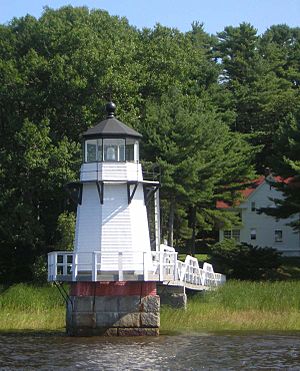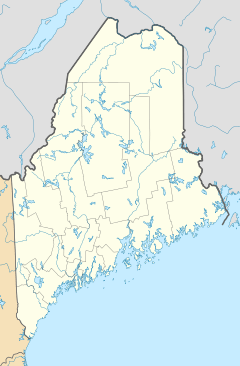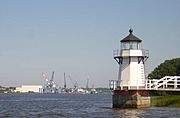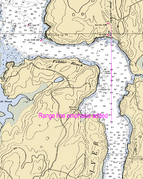Doubling Point Light facts for kids
 |
|
| The keeper's house is under the trees | |
|
|
|
| Location | Kennebec River, Arrowsic, Maine |
|---|---|
| Coordinates | 43°52′57.0″N 69°48′24.5″W / 43.882500°N 69.806806°W |
| Year first constructed | 1898 |
| Automated | 1988 |
| Tower shape | Octagonal Wood Tower |
| Markings / pattern | White |
| Focal height | 23 feet (7.0 m) |
| Range | 9 nautical miles (17 km; 10 mi) |
| Characteristic | Fl W 4s |
| Fog signal | none |
| USCG number | 1-6145 |
Doubling Point Light is a historic lighthouse located on the Kennebec River in Arrowsic, Maine. It was built in 1898 to help ships navigate the river safely. This lighthouse was part of a big project to improve lighting along the Kennebec River, especially important for ships going to places like the Bath Iron Works, a large shipbuilding company nearby.
The Doubling Point Light, along with other nearby lights like the Range Lights, Perkins Island Light, and Squirrel Point Light, were all built around the same time. Today, Doubling Point Light is still active, guiding boats and ships along the river. It was also added to the National Register of Historic Places in 1988, recognizing its importance.
Contents
What is Doubling Point Light?
Doubling Point Light stands on the lower part of the Kennebec River. This spot is special because the river makes a sharp turn here. The lighthouse helps ships know where to go, especially around this bend.
The lighthouse station includes several buildings:
- A tall tower where the light shines from.
- A keeper's house where the lighthouse keeper used to live.
- A small shed for tools.
- An oil house for storing the oil that powered the light.
The Lighthouse Tower
The tower itself is shaped like an octagon, which means it has eight sides. It's made of wood and covered with wooden shingles. Around the very top, where the light is, there's an iron walkway. To reach the tower, you walk across a footbridge with three sections.
The Keeper's House
Near the tower is the keeper's house. This is a one-and-a-half-story wooden building. It has porches with sloped roofs, making it look cozy. The tool shed, built in 1898, has a pointed roof. The small brick oilhouse was added a bit later, in 1906.
Why Was This Lighthouse Built?
The city of Bath, Maine, located north of Doubling Point, was a very important shipbuilding city in the 1800s. The Kennebec River was like a highway for ships, all the way up to Augusta.
In 1892, people realized that the river below Bath needed better ways to guide ships. These guides are called "navigational aids." So, a plan was made to improve the lights. Money for this project was approved by the government in 1895.
Doubling Point Light was then built in 1898, along with the keeper's house and shed. Interestingly, the tower wasn't always in its exact spot. It was moved to its current location in 1899. The keeper's house was also moved closer to the tower in 1901.
The original light in the tower used a special type of lens called a fifth-order Fresnel lens. This lens was designed to make the light beam very strong and focused. In 1988, the lighthouse became "automated," which means machines took over the job of the lighthouse keeper, and the light now runs by itself.
Gallery
-
The light as shown on NOAA chart 13296






